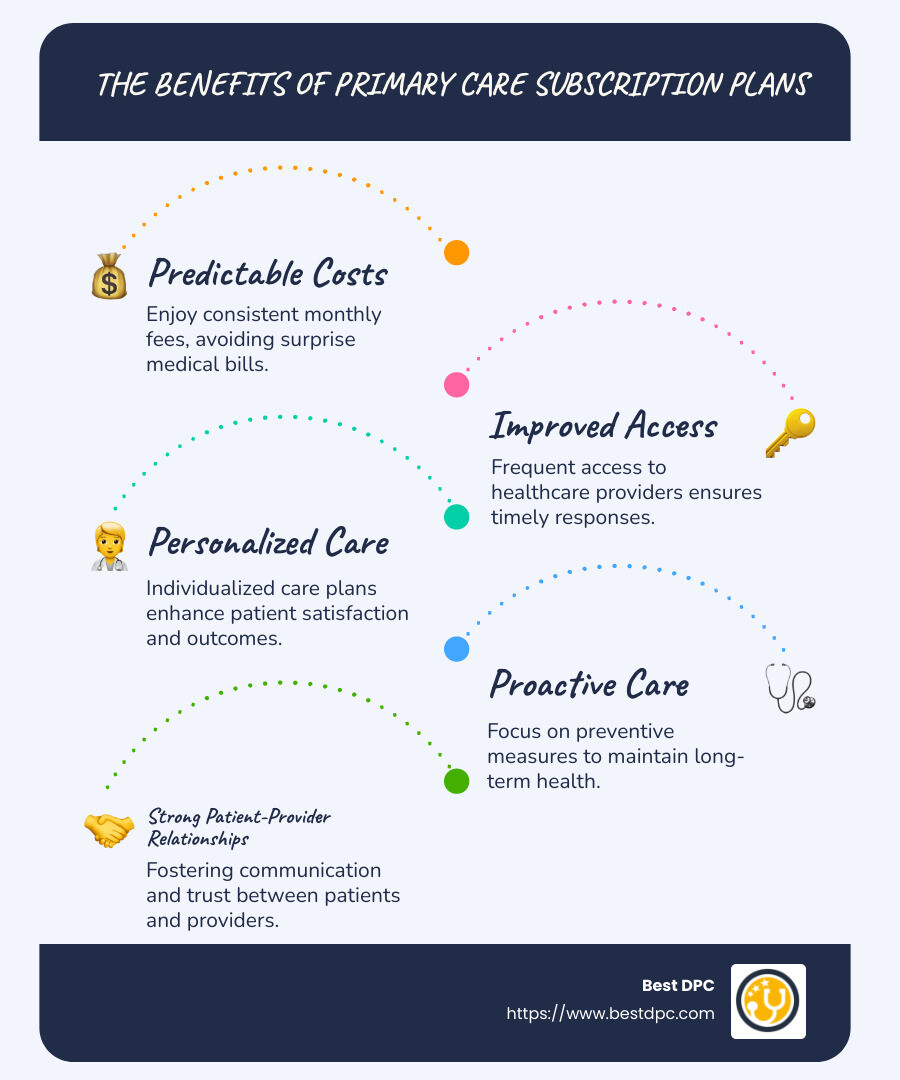Wayne Lowry

Primary care subscription plan offers a modern twist on accessing healthcare, combining affordability, accessibility, and personalized care. These plans are reshaping how we think about medical services:
Finding affordable, predictable healthcare is challenging in today’s environment. Primary care subscription plans promise to revolutionize how we approach our health. These subscriptions, often likened to a gym membership for healthcare, emphasize building strong patient-provider relationships and ensuring proactive care.
With the rising costs of traditional healthcare, more individuals are seeking options that offer both financial predictability and personal attention. A subscription model helps alleviate some common pain points by focusing on patient needs and fostering communication with healthcare providers.

Understanding Primary Care Subscription Plans
Primary care subscription plans are changing healthcare by offering a simple, predictable way to access medical services. These plans use a subscription model, which means you pay a flat fee each month. This fee covers a wide range of primary healthcare services, making it easier to manage your healthcare budget.
The Subscription Model: A New Way to Pay
Instead of paying for each doctor visit or test separately, you pay one monthly fee. This flat fee covers most of your primary care needs, such as check-ups, preventive care, and managing chronic conditions.
Why is this beneficial?
Focus on Preventive Care
Preventive care is a big part of these plans. Doctors work with you to prevent illnesses before they start. This might include regular screenings, vaccinations, and lifestyle advice.
Benefits of Preventive Care:

How It Works
Think of it like a gym membership. You pay a monthly fee, and you can use the services as much as you need. This model encourages you to see your doctor regularly and not wait until you’re really sick.
In places like Henderson, NC, Baton Rouge, LA, and Riverton, WY, primary care subscription plans are making healthcare more accessible and less stressful. They focus on what matters most: keeping you healthy and informed.
Understanding and choosing the right primary care subscription plan can be a game-changer for your health and your wallet.
Benefits of Primary Care Subscription Plans
Primary care subscription plans bring a host of benefits that can transform your healthcare experience. Let’s explore the key advantages: cost savings, personalized treatment, and improved access.
Cost Savings
One of the biggest perks of a primary care subscription plan is the potential for cost savings.

Personalized Treatment
With a primary care subscription plan, personalized treatment becomes a reality.
Improved Access
Access to healthcare is crucial, and subscription plans make it easier.
By focusing on cost savings, personalized treatment, and improved access, primary care subscription plans are redefining how we experience healthcare.
Next, we’ll explore how these subscription models compare to traditional fee-for-service systems and why they might be the right choice for you.
Comparing Fee-For-Service and Subscription Models
When it comes to healthcare, the primary care subscription plan and the fee-for-service model offer two very different experiences. Let’s break down how they compare, focusing on proactive care and the patient-provider relationship.
Fee-For-Service Model
In the traditional fee-for-service model, healthcare providers are paid for each service they perform. This means every visit, test, or procedure has a separate charge.

Subscription Models
On the flip side, subscription models offer a more integrated approach to healthcare.
Emphasizing Patient-Provider Relationships
A strong patient-provider relationship is a game-changer in healthcare. Subscription models excel here by allowing doctors to truly know their patients.
As healthcare continues to evolve, subscription models are gaining popularity for their focus on proactive care and building strong patient-provider relationships. They offer a refreshing alternative to the traditional fee-for-service approach, making healthcare more accessible and personalized.
Next, we’ll dive into the role of Direct Primary Care in these subscription plans and how it’s reshaping the healthcare experience.
The Role of Direct Primary Care in Subscription Plans
Direct Primary Care (DPC) is a key player in primary care subscription plans. It puts patients first and offers comprehensive care without the hassle of insurance.
What Makes DPC Unique?
DPC is all about simplicity and focus. Patients pay a flat monthly fee for a wide range of services, like regular check-ups and preventive care. This model removes the need for insurance billing, making healthcare straightforward and stress-free.

Benefits of DPC in Subscription Plans
Real-World Impact
Direct Primary Care (DPC) is revolutionizing healthcare by putting the patient at the heart of the system. This approach provides a straightforward alternative to traditional models, emphasizing what really counts — your health and wellness.

With DPC, you gain personalized and patient-focused care that prioritizes your needs and simplifies your healthcare experience.
Next, we’ll address some common questions about primary care subscription plans to help you make informed decisions.
Frequently Asked Questions about Primary Care Subscription Plans
Is a primary care subscription plan worth it?
Absolutely, especially if you value personalized medicine and preventive care. With a primary care subscription plan, you get a healthcare experience custom to your unique needs. Doctors have more time to understand your health history, lifestyle, and goals. This allows them to create personalized treatment plans that address your specific concerns.
Preventive care is a major focus in these plans. Regular check-ups and screenings help catch potential health issues early. This proactive approach can lead to better health outcomes and fewer emergencies down the line.
What are the disadvantages of subscription plans?
While there are many benefits, it’s important to be aware of some limitations. One major drawback is limited coverage. These plans typically cover primary and preventive care but may not include services like surgeries, hospitalizations, or specialist visits.
This means you might face out-of-pocket costs for services not covered under your subscription. It’s wise to consider supplemental coverage options, such as healthsharing plans, to fill these gaps. Healthsharing plans can help cover unexpected medical expenses, making them a popular choice among subscription plan members.
How do subscription plans differ from insurance?
Subscription plans are not insurance. They offer a simplified approach to managing primary care by charging a flat fee for a range of basic services. Unlike traditional insurance, these plans do not cover catastrophic events or specialized treatments.
However, subscription plans can complement insurance by providing consistent, affordable access to primary care. Many people find that combining a subscription plan with a high-deductible insurance policy or a healthshare plan offers a comprehensive healthcare solution.
Thus, while a primary care subscription plan provides great value for routine and preventive care, it’s important to consider your overall healthcare needs. Balancing these plans with supplemental options can ensure you have complete coverage for all potential medical situations.
Conclusion
The future of healthcare is here, and it’s called Best DPC. With primary care subscription plans, Best DPC is leading a healthcare revolution that focuses on patient satisfaction. By offering a patient-centered approach with flat monthly fees, Best DPC eliminates the hassle of insurance, making healthcare more accessible and affordable.
Patients can enjoy personalized care that puts their needs first. With regular check-ups and preventive care, they can catch health issues early, leading to better outcomes and fewer emergencies. This proactive approach ensures that patients feel valued and understood, fostering stronger relationships with their healthcare providers.
Best DPC’s model is not just about cost savings; it’s about changing the healthcare experience. Patients have direct access to their providers, ensuring timely responses to their health concerns. This level of attention and care is what sets Best DPC apart.
If you’re ready to explore a new era of healthcare, consider joining the Best DPC family. Experience the benefits of a primary care subscription plan and take control of your health today.
Find more about Best DPC and find a provider near you. Your health deserves the best.

ABOUT AUTHOR
Wayne Lowry
Wayne Lowry, Founder of BestDPC, is a passionate advocate for Direct Primary Care (DPC) and its mission to deliver personalized, accessible healthcare. He believes that DPC providers should serve as the trusted first point of contact for all medical needs, ensuring patients never feel isolated or uncertain about their health decisions. Through his work, he champions a patient-first approach to healthcare, building a system that prioritizes guidance, support, and trust.

Thank You for Registering!
Your registration was successful! We're excited to have you on board. Please check your email for a confirmation link to complete your registration.